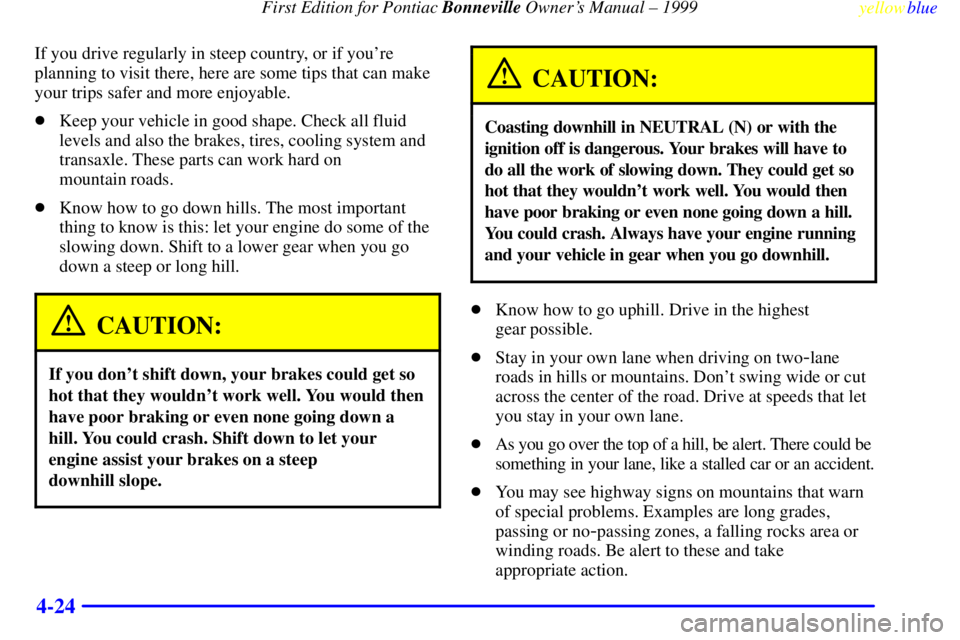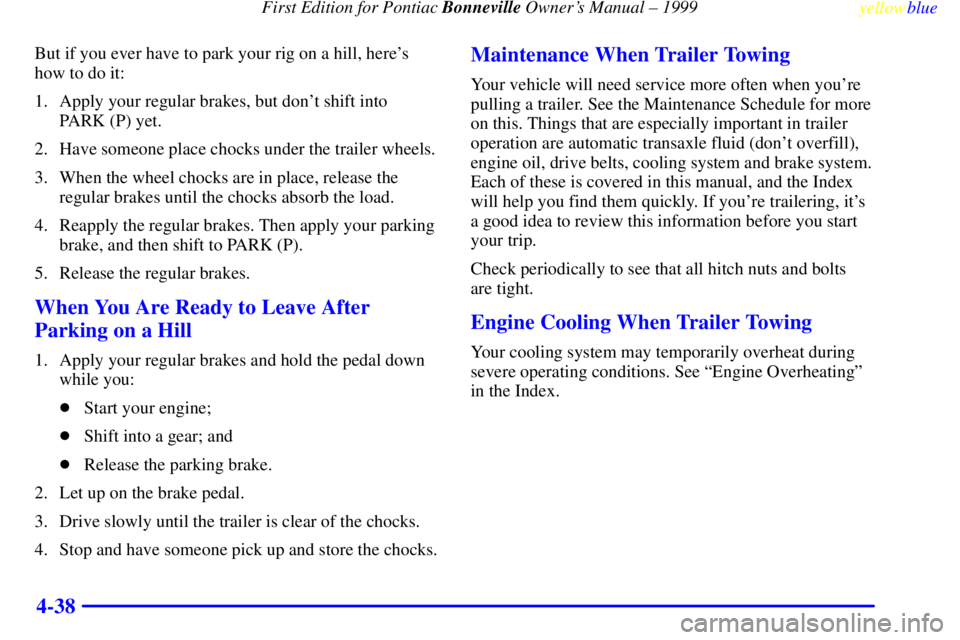Page 136 of 392
yellowblue
2-76 Systems Monitor (Option)
If you have the Systems
Monitor, it gives you
important safety and
maintenance facts.
When you turn the ignition on, the Systems Monitor and
warning lights will briefly light up. If a problem is
detected, the warning lights will turn on.The following warning lights are displayed in the
Systems Monitor:
�Check Oil Level: This message could mean your oil
level is low. If it comes on for more than three
seconds, see ªCheck Oil Level Warning Lightº in
the Index.
�Washer Fluid: This message means your washer
fluid tank is less than about 30 percent full. If this
light comes on, see ªWindshield Washer Fluidº in
the Index.
�Check Doors: This message means that either the
driver's door or one of the passenger's doors is not
completely closed. If this light comes on, see ªCheck
Doors Lightº in the Index.
�Brake: If this message comes on while you are
driving, it means there is a brake problem. See
ªBrake System Warning Lightº in the Index.
Page 141 of 392

yellowblue
2-81
FUNCTION MONITOR: This lets you know if
you are low on fluids or have a problem with a
vehicle function:
�CHECK OIL LEVEL: This message could mean
your oil level is low. If it comes on for more than
three seconds, see ªCheck Oil Level Warning Lightº
in the Index.
�WASHER FLUID: This message means your
washer fluid tank is less than about 30 percent full.
The windshield portion of the vehicle outline will
also glow. If these come on, see ªWindshield Washer
Fluidº in the Index.
�LOW COOLANT: This message means your
coolant level has fallen to about half full. If it comes
on, see ªEngine Coolantº in the Index.
�CHECK GAGES: If this light comes on and stays
on while you are driving, check your gages for fuel,
coolant temperature, oil pressure or battery voltage.
SECURITY MONITOR: The vehicle outline will
illuminate to let you know the following information:
�DOOR AJAR: This message means a door is not
fully closed. The vehicle outline will show you
which door it is.�TRUNK AJAR: This message appears if the trunk is
not fully closed. The vehicle outline will illuminate.
�HOOD AJAR: This message appears if the hood is
not fully closed. The vehicle outline will illuminate
if the hood is not latched properly.
LAMP MONITOR: Whenever you try to use one of
the following lamps, the LAMP MONITOR will tell you
if a bulb is out.
�Headlamp (Low and High Beam)
�Parking Lamp/Sidemarker
�Turn Signal/Parking/Stop
�Back
-Up Lamp
�Taillamp/Turn/Sidemarker/License
�Brake Lamp and Center High
-Mounted Stoplamp
If a bulb is out, you will see a message, such as PARK
LAMP, and you will also see where the problem is on
the vehicle outline. The message stays on until the
problem is fixed. See ªReplacement Bulbsº in the Index
for bulb details.
Page 202 of 392

First Edition for Pontiac Bonneville Owner's Manual ± 1999
yellowblue
4-24
If you drive regularly in steep country, or if you're
planning to visit there, here are some tips that can make
your trips safer and more enjoyable.
�Keep your vehicle in good shape. Check all fluid
levels and also the brakes, tires, cooling system and
transaxle. These parts can work hard on
mountain roads.
�Know how to go down hills. The most important
thing to know is this: let your engine do some of the
slowing down. Shift to a lower gear when you go
down a steep or long hill.
CAUTION:
If you don't shift down, your brakes could get so
hot that they wouldn't work well. You would then
have poor braking or even none going down a
hill. You could crash. Shift down to let your
engine assist your brakes on a steep
downhill slope.
CAUTION:
Coasting downhill in NEUTRAL (N) or with the
ignition off is dangerous. Your brakes will have to
do all the work of slowing down. They could get so
hot that they wouldn't work well. You would then
have poor braking or even none going down a hill.
You could crash. Always have your engine running
and your vehicle in gear when you go downhill.
�Know how to go uphill. Drive in the highest
gear possible.
�Stay in your own lane when driving on two
-lane
roads in hills or mountains. Don't swing wide or cut
across the center of the road. Drive at speeds that let
you stay in your own lane.
�As you go over the top of a hill, be alert. There could be
something in your lane, like a stalled car or an accident.
�You may see highway signs on mountains that warn
of special problems. Examples are long grades,
passing or no
-passing zones, a falling rocks area or
winding roads. Be alert to these and take
appropriate action.
Page 216 of 392

First Edition for Pontiac Bonneville Owner's Manual ± 1999
yellowblue
4-38
But if you ever have to park your rig on a hill, here's
how to do it:
1. Apply your regular brakes, but don't shift into
PARK (P) yet.
2. Have someone place chocks under the trailer wheels.
3. When the wheel chocks are in place, release the
regular brakes until the chocks absorb the load.
4. Reapply the regular brakes. Then apply your parking
brake, and then shift to PARK (P).
5. Release the regular brakes.
When You Are Ready to Leave After
Parking on a Hill
1. Apply your regular brakes and hold the pedal down
while you:
�Start your engine;
�Shift into a gear; and
�Release the parking brake.
2. Let up on the brake pedal.
3. Drive slowly until the trailer is clear of the chocks.
4. Stop and have someone pick up and store the chocks.
Maintenance When Trailer Towing
Your vehicle will need service more often when you're
pulling a trailer. See the Maintenance Schedule for more
on this. Things that are especially important in trailer
operation are automatic transaxle fluid (don't overfill),
engine oil, drive belts, cooling system and brake system.
Each of these is covered in this manual, and the Index
will help you find them quickly. If you're trailering, it's
a good idea to review this information before you start
your trip.
Check periodically to see that all hitch nuts and bolts
are tight.
Engine Cooling When Trailer Towing
Your cooling system may temporarily overheat during
severe operating conditions. See ªEngine Overheatingº
in the Index.
Page 251 of 392

6-
yellowblue
6-1
Section 6 Service and Appearance Care
Here you will find information about the care of your vehicle. This section begins with service and fuel information,
and then it shows how to check important fluid and lubricant levels. There is also technical information about your
vehicle, and a part devoted to its appearance care.
6
-2 Service
6
-3 Fuel
6
-5 Fuels in Foreign Countries
6
-6 Filling Your Tank
6
-9 Filling a Portable Fuel Container
6
-9 Checking Things Under the Hood
6
-13 Engine Oil
6
-17 Engine Air Cleaner/Filter
6
-20 Automatic Transaxle Fluid
6
-23 Radiator Pressure Cap
6
-24 Engine Coolant
6
-27 Power Steering Fluid
6
-28 Windshield Washer Fluid
6
-29 Brakes
6
-32 Battery
6
-33 Bulb Replacement6
-43 Windshield Wiper Blade Replacement
6
-44 Tires
6
-52 Appearance Care
6
-52 Cleaning the Inside of Your Vehicle
6
-55 Cleaning the Outside of Your Vehicle
6
-57 Cleaning Aluminum or Chrome-Plated
Wheels (If Equipped)
6
-57 Sheet Metal Damage
6
-59 GM Vehicle Care/Appearance Materials
6
-60 Vehicle Identification Number (VIN)
6
-61 Electrical System
6
-68 Replacement Bulbs
6
-69 Capacities and Specifications
6
-70 Air Conditioning Refrigerants
6
-70 Normal Maintenance Replacement Parts
Page 259 of 392

yellowblue
6-9
Filling a Portable Fuel Container
CAUTION:
Never fill a portable fuel container while it is in
your vehicle. Static electricity discharge from the
container can ignite the gasoline vapor. You can
be badly burned and your vehicle damaged if this
occurs. To help avoid injury to you and others:
�Dispense gasoline only into
approved containers.
�Do not fill a container while it is inside a
vehicle, in a vehicle's trunk, pickup bed or
on any surface other than the ground.
�Bring the fill nozzle in contact with the
inside of the fill opening before operating
the nozzle. Contact should be maintained
until the filling is complete.
�Don't smoke while pumping gasoline.
Checking Things Under the Hood
The following sections tell you how to check fluids,
lubricants and important underhood parts.
CAUTION:
An electric fan under the hood can start up and
injure you even when the engine is not running.
Keep hands, clothing and tools away from any
underhood electric fan.
CAUTION:
Things that burn can get on hot engine parts and
start a fire. These include liquids like gasoline,
oil, coolant, brake fluid, windshield washer and
other fluids, and plastic or rubber. You or others
could be burned. Be careful not to drop or spill
things that will burn onto a hot engine.
Page 261 of 392
yellowblue
6-11 3800 Series II Engine (L36 - Code K)
When you open the hood, you'll see:
A. Engine Coolant
Recovery Tank
B. Battery
C. Radiator Pressure CapD. Engine Oil Dipstick
E. Engine Oil Fill Cap
F. Automatic Transaxle
Fluid DipstickG. Brake Master Cylinder
H. Air Cleaner
I. Windshield Washer
Fluid Reservoir
Page 262 of 392
yellowblue
6-12 3800 Supercharged Engine (L67 - Code 1) (If Equipped)
When you open the hood, you'll see:
A. Engine Coolant
Recovery Tank
B. Battery
C. Radiator Pressure CapD. Engine Oil Dipstick
E. Engine Oil Fill Cap
F. Automatic Transaxle
Fluid DipstickG. Brake Master Cylinder
H. Air Cleaner
I. Windshield Washer
Fluid Reservoir